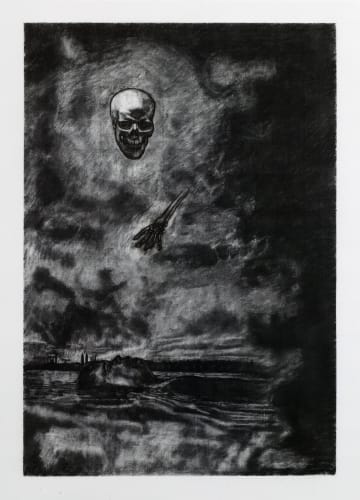“You can talk about your masturbatory fantasies - or your indifference to politics - but your taste for the sublime? Imagine the knowing cackles on Leno, Letterman, or Conan O Brien.”
Anthony Hayden Guest
“I wanted to feel like what it was like to plot to scheme.”
Philip Guston
“With gothic we can tell our selves that we live in the worst & most barbaric of times, that all is broken never to be mended, things are bad & fated to be, significant hope is a sorry joke- the prerogative of suckers. The gothic dark as it is offers epistemological certainty, it allows us to believe we have found the truth.”
Mark Edmundson
“Almost all art that could be called Gothic has an ironic edge: It's aware of its position, even the absurdity of its position, yet it persists with sincere tongue in ironical cheek.”
Jerry Saltz
“… it starts with the pleasure of putting charcoal marks on paper, you immediately see two things - a sheet of paper with charcoal dust across its surface and the evocation of a landscape with a sky - There’s a simple alchemy in the transformation of the paper.”
William Kentridge
In spite of Anthony Hayden Guest’s warning about the sublime - which has undoubtedly become debased in recent decades - the working title for this exhibition was along the lines of ‘Southside Sublime’. The setting for most of Coyle’s latest drawings is his local environment, a subject matter which he has explored via various means in previous shows (Ad Marginem 2000, Death in Dún Laoghaire 2005 & 2006). He has used it a filter through which are fed various ideas about the landscape, the sublime & a slew of influences including Odile Redon, Caspar David Friedrich, Claude, Ribera, Manga and Guston.
Things began to coalesce when Coyle began to explore the Gothic – sublimes over stimulated younger sibling. Some of its basic tenets brought clarity to the enterprise such as the divided self, hero/ villain, one of the fundamental pillars of the Gothic. There’s the track suited man who appears in 3 of Coyle’s drawings - part Caspar David Friedrich’s visionary poet, part Dublin gangland villain (by way of one of Guston’s robed KKK men). These drawings provide the spine of the show as well as manifesting one of Gothic’s most enduring characteristics - a fragmented & inconsistent narrative.
Another central pillar of the gothic is the haunted house, which makes an appearance in the works Dalkey Island and Where the streets have no name, in the guise of modernist buildings – a sort of back to the future Claudesque re-imagining of the local landscape. Other works explore more traditional topics. Final girl 2 pits the ‘merely’ beautiful against the sublime, male versus female. Eyes in the forest explores the Gothic fascination with the tension between the artificial and the organic. Coyle’s self-portrait of the artist dead is a reworking of Redon’s series of prints The dream is over, in which he examines and mocks his own obsessions.


